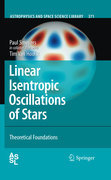
Linear isentropic oscillations of stars: theoretical foundations
Smeyers, Paul
Hoolst, Tim van
The study of stellar oscillations is the preeminent way to investigate the stability of stars and to interpret their variability. The theory of the linear,isentropic oscillations of isolated gaseous stars, and thus of compressible spherically symmetric equilibrium configurations, has largely been developed from the viewpoint of the hypothesis of the physical radial pulsations of stars.Written for doctoral students and researchers, this monograph aims to providea systematic and consistent survey of the fundamentals of the theory of free,linear, isentropic oscillations in spherically symmetric, gaseous equilibriumstars. The first part of the book presents basic concepts and equations, the distinction between spheroidal and toroidal normal modes, the solution of Poisson’s differential equation for the perturbation of the gravitational potential, and Hamilton’s variational principle. The second part is devoted to the possible existence of waves propagating in the radial direction, the origin and classification of normal modes, the completeness of the normal modes, and the relation between the local stability with respect to convection and the global stability of a star. The third part deals with asymptotic representations of normal modes and with slow period changes in rapidly evolving pulsating stars. Provides a comprehensive presentation of the fundamental aspects of the theoryof the linear, isentropic oscillations in spherically symmetric stars Intermediate steps in the mathematical derivations included With extensive appendiceson fundamental mathematical and theoretical physics problems INDICE: Introduction.- 1 Basic Concepts.- 2 The Equations governing LinearPerturbations in a quasi-Static Star.- 3 Deviations from the Hydrostatic and Thermal Equilibrium in a quasi-Static Star.- 4 Eigenvalue Problem of the Linear, Isentropic Normal Modes in a quasi-Static Star.- 5 Spheroidal and Toroidal Normal Modes.- 6 Determination of Spheroidal Normal Modes. Mathematical Aspects.- 7 The Eulerian Perturbation of the Gravitational Potential.- 8 The Variational Principle of Hamilton.- 9 Radial Propagation of Waves.- 10 Classificationof the Spheroidal Normal Modes.- 11 Classification of the Spheroidal Normal Modes (continued).- 12 Completeness of the Linear, Isentropic Normal Modes.- 13N2(r) nowhere Negative as Condition for Non-Radial Modes with Real Eigenfrequencies.- 14 Asymptotic Representation of Low-Degree, Higher-Order p-Modes.- 15Asymptotic Representation of Low- and Intermediate-Degree p-Modes.- 16 Asymptotic Representation of Low-Degree, Higher-Order g+-Modes in Stars containing aConvective Core.- 17 Asymptotic Representation of Low-Degree, Higher-Order g+-Modes in Stars consisting of a Radiative Core and a Convective Envelope.- 18 High-Degree, Low-Order Modes.- 19 Period Changes in a rapidly evolving pulsating Star.- Appendixes.- A Green’s Fundamental Formula of Potential Theory.- B The Thermodynamic Isentropic Coefficients.- C Lagrange’s Equations of Motion.- D Spherical Harmonics.- E Singular Perturbation Problems of the Boundary-LayerType.- F Boundary Condition Relative to the Pressure on a Star’s Surface.- G The Curl of a Vector Field.- H Eigenvalue Problem of the vibrating String.- I The Euler-Lagrange Equations of Hamilton’s Variational Principle for a perturbed Star.- J Acoustic Waves.- References.- Index.
- ISBN: 978-3-642-13029-8
- Editorial: Springer
- Encuadernacion: Cartoné
- Páginas: 485
- Fecha Publicación: 01/08/2010
- Nº Volúmenes: 1
- Idioma: Inglés
